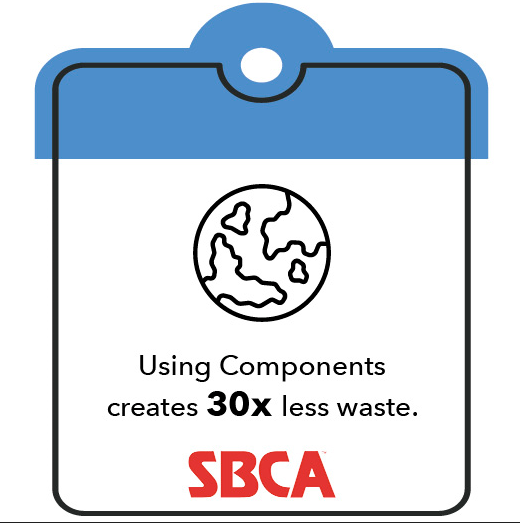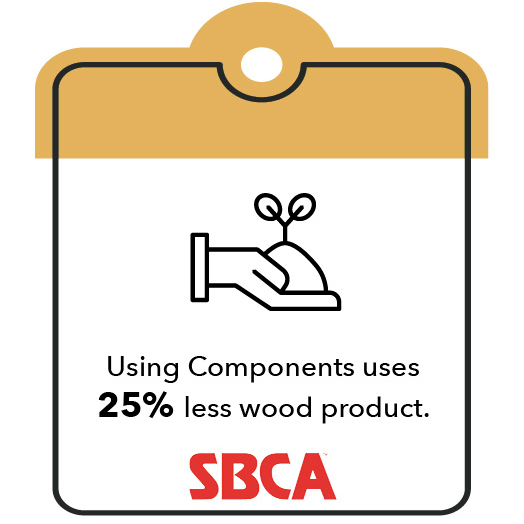Enhancing Construction Documents with BCSI
Originally Published by: SBCA Magazine — July 25, 2023
SBCA appreciates your input; please email us if you have any comments or corrections to this article.
A Valuable Tool for Architects, Designers, & Specifiers
Construction documents (CDs) are one of the most critical elements of any building project but what exactly are CDs, who creates them, and why are they so important to a project’s success and when building with components, where do they factor into the process of truss installation? This article aims to answer these questions and shed light on the crucial role of CDs in the successful execution of a construction project.
CDs are the final drawings and specifications that guide the actual construction of a building. CDs are a project’s overall map, in designing and completing the construction installation from start to finish, detailing everything from the architectural design to the structural, mechanical, and electrical systems. An essential part of every CD is the project specifications. If CDs are the map, specifications are the legend helping manufacturers, suppliers, contractors, and trades navigate the design’s intent by directing the project’s distinct details such as the building materials, techniques, and standards to be used throughout the construction process.
BCSI provides standardized details and instructions based on the latest industry research and the consensus of industry experts. For architects, designers, and specifiers, BCSI can be a valuable tool for enhancing CDs and specifications maximizing efficiency throughout the design and construction process by reducing rework, design clashes, and request for information (RFI), enhancing on-site safety, and improving the building systems overall quality and performance by leveraging the performative benefits of components as part of the design intent.
 Reducing Rework, Design Clashes, & RFIs | BCSI provides examples and best practices for truss installation. By incorporating these into your CDs, you can reduce the likelihood of errors during installation, minimizing the need for rework and RFIs. It also helps prevent design clashes between disciplines as well as conflicts on the plan and in the field by proactively addressing issues like clearance requirements and the placement of mechanical systems.
Reducing Rework, Design Clashes, & RFIs | BCSI provides examples and best practices for truss installation. By incorporating these into your CDs, you can reduce the likelihood of errors during installation, minimizing the need for rework and RFIs. It also helps prevent design clashes between disciplines as well as conflicts on the plan and in the field by proactively addressing issues like clearance requirements and the placement of mechanical systems.
Enhancing Safety & On-site Efficiency | BCSI stresses safety in truss installation. Guidelines on issues like temporary bracing, load restrictions, and fall protection are provided to keep the workers safe and mitigate incident driven schedule delays. By incorporating these safety guidelines into your CDs, you can help ensure a safer and more efficient jobsite.
 Leveraging the Performative Benefits of Components | Trusses offer several performative benefits, including strength, flexibility in design, span, and efficient use of materials. BCSI offers information on how to maximize these benefits, such as guidance on optimal truss spacing and bracing techniques. By incorporating this information into your CDs, you can guarantee that your designs fully exploit the advantages of trusses for optimal building performance.
Leveraging the Performative Benefits of Components | Trusses offer several performative benefits, including strength, flexibility in design, span, and efficient use of materials. BCSI offers information on how to maximize these benefits, such as guidance on optimal truss spacing and bracing techniques. By incorporating this information into your CDs, you can guarantee that your designs fully exploit the advantages of trusses for optimal building performance.
The Role of Construction Documents in Truss Installation | In the context of truss installation, CDs play a pivotal role. They provide crucial information for Truss Design Drawings and Truss Placement Diagrams such as specifications and load requirements. These documents guide the construction team through the installation process, from understanding the requirements for installation, following the instructions during installation, to inspecting the installed trusses for conformance.
- Truss Design Drawings: These detail the design, dimensions, and materials of each truss. They also specify the location and type of connector plates and any special requirements for handling, installation, and bracing.
- Truss Placement Diagram: This shows the location of each truss in the building structure. It's fundamental for verifying trusses are installed in the correct position and orientation.
- Specifications: These provide detailed information on the materials to be used, the standards to be followed, and the methods of installation. They may also specify the required inspections and tests.
- Load Information: The documents specify the loads that each truss is designed to carry, including dead loads (the weight of the truss and any permanent fixtures), live loads (temporary loads such as people and furniture), and environmental loads (wind, snow, etc.).
CDs are referenced at various stages throughout the installation process…
- Before Installation: The construction team reviews the Truss Design Drawings, the Truss Placement Diagram, and the specifications to understand the requirements for installation.
- During Installation: The team follows the instructions in the documents to install and brace the trusses. They also use the load information to ensure that the trusses are not overloaded during construction.
- After Installation: The team inspects the installed trusses to ensure they conform to the Truss Design Drawings and double checks that all permanent restraints and bracing (CLRs) are properly installed. If any damage or non-conformance is found, it is reported to the Truss Manufacturer, and the necessary repairs are carried out according to the instructions in the documents.
CDs are the backbone of any construction project, providing a detailed roadmap for the design and construction process. BCSI, with its wealth of information, can significantly elevate these documents, streamlining stakeholder communication and coordination, translating into safer more efficient onsite installation practices, and positively influence the final product by taking full advantage of the performative benefits of components at the design stage. Architects, designers, and specifiers, leveraging tools like BCSI and working in collaboration with Component Manufactures are key measures available to create effective CDs that become successfully executed and high performing buildings.
